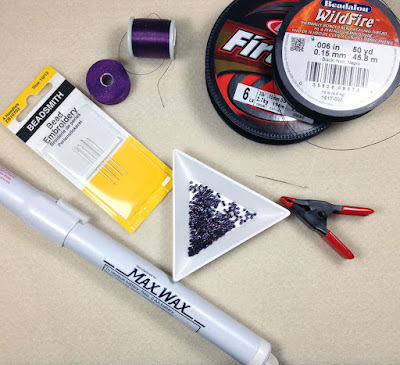 |
| Beads, Beading Thread, Bead Embroidery Needles, a Mini-Clip and a Thread Burner |
List of Materials & Tools
Beads
Miyuki Delicas Size 11 work well. They are incredibly regular, have large holes and come in great color choices.
Beading Thread
I have tried a range of beading thread for this project and now choose my thread solely based on best color match, not based on breaking strength as there is no need for great structural strength for this project, nor do I choose based on thread type.
Here is the list of thread according to their breaking strength, : KO or Miyuki Beading Thread, 6 lb FireLine, C-Lon Bead Thread Size D, and WildFire .006. Respectively, they have 4 lb, 6 lb, 7 lb & 10 lb breaking strength.
As to thickness of chread, they are all thin thread, but they list from thinnest to very thin in this order: KO/Miyuki, C-Lon Bead Thread Size D, 6lb FireLine, WildFire. The first two flatten the most, the last two are rounder, but will flatten a bit against a bead hole.
KO and Miyuki Beading Thread are exactly the same product, nylon filaments laid side by side without being twisted in plies in a monocord waxed together. C-Lon Bead Thread Size D is similar but thicker and it has no wax, just a very light bond. WildFire is a thermally bonded nylon filament, white in its center with a black, frost white or camouflage green thermally bond over the filaments. FireLine is similar to WildFire, but it comes in a dark grey, smoke color and a white named crystal, both are slightly transparent. They all have their own feel, but in the end for this particular project all of them will work well.
The major factor for a good result is an even thread tension, and that will improve with practice. Don't stress, this project is forgiving, even on the first try!
Bead Embroidery Needles
Blunt ends are better than regular beading needles. The blunt ends lowers the likelihood of splitting the thread when going through the beads multiple times. Plus they are short and no length is needed for this project.
Mini-Clamp
I found a mini-clamp much better than using a bead as a stopper, plus I already had one laying around on my desk from the tool kit of the Kumihimo Bracelet with Long Magatamas & C-Lon Tex 400 Bead Cord.
Thread Burner
Great for melting the end of the thread. Alternatives: Cut the thread after taking it around the same several beads over and over. Add a drop of Fray Check or GS Hypo Cement for added security is so desired.
Optional - Beeswax
Good for the ends of C-Lon Bead Thread Size D. It prevents the ends from splitting when threading them into the needle. KO and Miyuki Thread is already waxed, but might need an additional waxing. WildFire & FireLine do not need any wax but the end needs to be flattened a bit before threading it.
We will be covering the magnetic tube with a flat, even-count peyote stitch by first making a flat rectangle and then zipping it into a tube. Even-count means that the number of beads along the length of the peyote stitch is an even number, such as 18 beads, which is the number that will cover the length of the clasp in this instance.
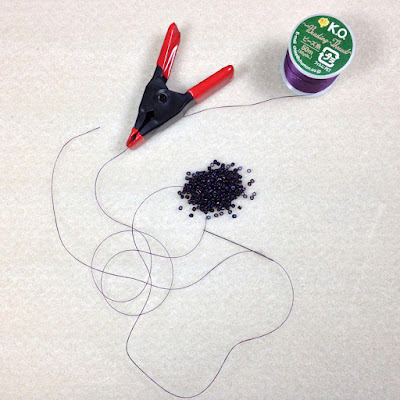 |
| 1. Thread the needle. Place the mini-clamp at 24 to 36 inches from the thread end. |
Note: If I have the full spool I tend not to cut the thread off the spool until I have completed the first half of the peyote rectangle just in case I damage the thread and need extra length on the spool side. If you are working with a 48 inch thread length, clamp it at 24 inches.
 |
| 2. Load 18 Delica Size 11 beads. Check the length of the beads against the clasp. |
 |
| 3. Push the beads against the mini-clamp. These beads will become the row 1 & 2. |
 |
| 4. For row 3, load 1 bead and go back into row 1 & 2. Skip the first bead, insert the needle through the second bead and pull the thread. |
 |
| 5. Step completed. |
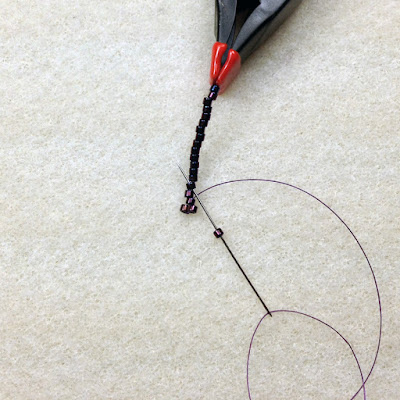 |
| 6. Continue, skip a bead, insert the needle through the next bead and pull the thread through. |
 |
| 7. Step 5 completed, continue, skip a bead, insert the needle into the next bead and pull the thread. |
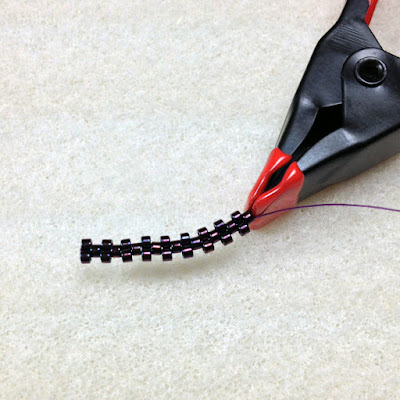 |
| 8. Rows 1, 2 and 3 completed. Rows in peyote stitch are counted diagonally. See 2 needle alternate start method listed in references below. |
 |
| 9. For row 4, add a bead, and go through the last bead added in the previous row. This will be the way you start all the future rows. |
 |
| 10. Step 8 completed. Continue the row. |
 |
| 14. Check the fit around the clasp. Join both sides for the flat peyote into a tube. Zip the two sides together by zigzagging through the beads on the edge of both sides. |
 |
| Same bracelet with Copper Delica Size 11 Sleeve |
 | |||
| Same Bracelet with Copper Seed Beads Size 11 Sleeve. The count is 16 beads wide by 14 beads on the edges with Miyuki Duracoat Galvanized Size 11 Seed Beads. > See tutorial for this sleeve |
Note: See next blog entries coming soon showing this same process with seed beads and an odd-count peyote with mixed delicas and seed beads.
Same Bracelet with Dark Plum Delicas Size 10 & Copper Seed Beads Size 11 Sleeve
> See tutorial for this sleeve
> See tutorial for this sleeve
Related Peyote Stitch Tutorials
Even-Count Peyote Sleeve with Seed Beads Size 11
Materials & Tools
Peyote Beaded Sleeves
Kumihimo Bracelet with Long Magatamas & C-Lon Tex 400 Bead Cord
KO/Miyuki Beading Thread
C-Lon Beading Thread Size D
WildFire Beading Thread
Bead Embroidery Needles
Beeswax
Magnetic End Clasps in Gold or Silver Tone
Related Posts
Why add Beaded Sleeve over a Magnetic Clasps? Beside the esthetic…
Thread Burners Review

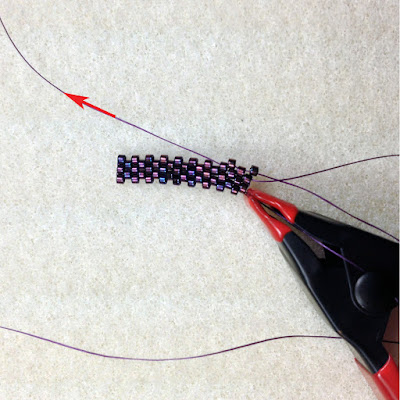

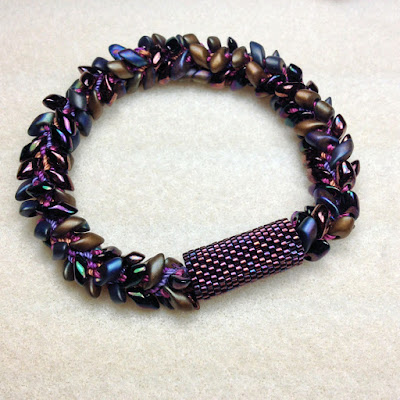












No comments:
Post a Comment